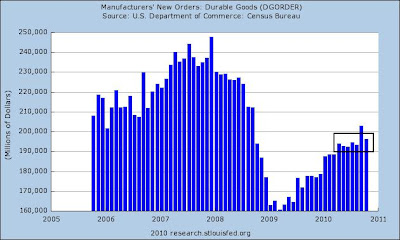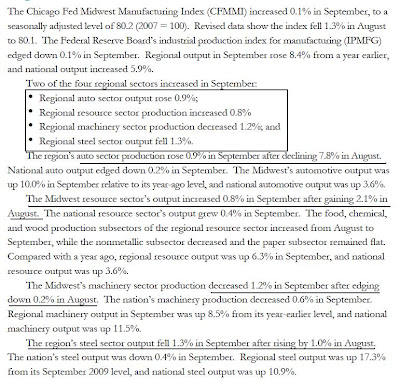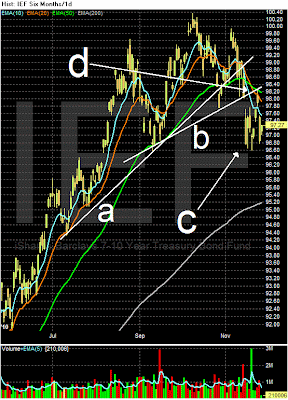- by New Deal democratThis blog has been totally silent on the "Foreclosuregate" crisis - and after this post, likely will continue to be. That isn't an oversight or a blind spot on our part. It is intentional, and for a very good reason -- there's no public data available to back up an objective assessment. Bonddad recently added a tagline from Jon Stewart to this blog's title. For my part, I'd choose "The Data, the Whole Data, and Nothing But the Data." In short, we have made a conscious decision (that we are constantly revisiting!) to keep this blog focused on data, and in the case of foreclosuregate, there is virtually none.
Broadly speaking, foreclosuregate occurs right at the intersection of law and the economy. On the one hand, it is a matter of due process, of access to and alleged wholesale fraud upon the courts -- and the remedies and punishments for violations. On the other hand, there are massive amounts of financial transactions and wealth potentially at issue. But the two parts of foreclosuregate are generally separate.
The legal issue -- of "robosigners," of incidents where the wrong bank may have foreclosed on a property, of foreclosing where homeowners rightfully or wrongfully believed they had negotiated forebearance through HAMP, and even one or two cases where a homeowner had no mortgage whatsoever but had foreclosure proceedings initiated against them anywhay -- has been
ably and throughly covered by
Barry Ritholtz at The Big Picture, with the appropriate sense of outrage. I am in full agreement with those feelings and have nothing significant to add.
But the legal issue has little effect on the economy. Virtually all of the due process concerns are that while the homeowner is in arrears on their mortgage, the plaintiff has failed to proceed in accordance with the law, and may have committed fraud or something close to it in order to hurry the proceedings. In other words, in the vast, vast majority of cases, the ultimate legal outcome would be the same -- the house would be foreclosed upon. In those situations where a homeowner was current on their mortgage, or had no mortgage at all, the bare minimum of judicial competence will resolve the issue in the homeowner's favor. While the homeowner may have had to hire a lawyer (although homeowners appearing on their own in this circumstance are likely to be given a great deal of deference by judges), but aside from that there is no economic harm. And of course, if a house without a mortgage or a current mortgage were foreclosed upon, you can expect that the media would be only too happy to publicize the case, with predictable immediate results.
In short, the legal issue, while potentially large in the judicial and possibly even criminal sense, is almost certainly not going to have a significant
economic impact.
The second portion of Foreclosuregate are the economic issues. Generally, there are two parts to this impact. The first is whether there will be clouds upon the title of thousands if not milions of properties, because of the possibility that the wrong party plaintiff foreclosed upon the property. The second issue is that of "putbacks" -- where, because the originator failed to live up to its covenants when it sold and securitized the mortgages, ginormous amounts of bazillions of dollars in transactions are "put back" to the originator, which is frequently a large Wall Street entity, which means it is insolvent and so Wall Street is insolvent and
We're All DOO ... !!!(Oh, sorry, sometimes I get ahead of myself in all the excitement.)
Let's look at each of these in turn.
The
"cloud upon title" issue simplifies to this: Bank A was the rightful owner of the mortgage note, but Bank B erroneously or fraudulently foreclosed on the property. Innocent Buyer C thinks they own the property free and clear when along comes Bank A who says, not so. Faced with perhaps tens if not hundreds of thousands of properties falling into this category, the title insurance system freezes up, and nobody will buy a foreclosed property.
Except it is not unreasonable for a legislature or a court to ask Bank A, "Did you record your mortgage note at the courthouse? You didn't??? Well then, if you couldn't be bothered, we can't be bothered either. You have no rights against Innocent Buyer C, but only a cause of action against Bank B." This solution is so obvious that I have to think courts and legislatures will immediately adopt it if and when the "cloud upon title" issue ever becomes significant.
The
"putback" issue is potentially much more serious. If originators in wholesale fashion violated their conenant with the buyers of mortgage backed securities to ensure that the securities were as represented, then the possibility exists of tens or hundreds of billions of dollars worth of securities being forced down the gullet of some very big and very vulnerable banks.
But again, this is subject to legislative action and judicial interpretation. For example, Judges can impute a duty of "due diligence" to the allegedly sophisticated buyers, and refuse putbacks if they failed to verify the status of the goods they were buying. Legislatures or the Judiciary could also by law or decision impute a Statute of Limitation or Doctrine of Laches to putback covenants. For example, if Congress were to pass a law interposing a 4 year Statute of Limitations for private lawsuits to enforce putback covenants (meaning that, if you failed to assert your rights within 4 years of the execution of the contract, your right has expired and no longer exists), then no covenants from 2006 or before would be at risk (although in my example criminal actions, and actions by the state and federal governments could still be undertaken). Even without legislative action, a court could accomplish the same thing via the equitable doctrine of Laches (simply put, you slept on your rights).
Even without any legislative or judicial action, you can expect that both sides to any putback action will arm themselves with batteries of lawyers and accountants, and ultimately make a dollars-and-cents decision about settlement, potentially after years of litigation. In other words, there are an awful lot of factors militating against the worst case scenario.
Finally, for the worst case scenario to unfold, Congresscritters and Presidential candidates who have scored $$$ Millions in grift - er, donations - from the financial industry would have to decide to, figuratively speaking, "let it burn," regardless of the impact on the economy. Now, it is one thing to accuse them as being dumb as toast or even malicious - as they have already proven a number of times this year - but it is another thing entirely to expect them to act to destroy their campaign contributors.
In summary, Foreclosuregate has the potential to be a financial catastrophe - but only if a lot of poor choices, chiefly political and judicial, are made. Or it could have the economic impact of a mild nuisance. Or somewhere in between. There is no data, only opinions, and as the saying goes, just like a*******, everybody has 'em.
How will it turn out? I don't know. And neither do the people loudly and hysterically proclaiming
DOOM!































